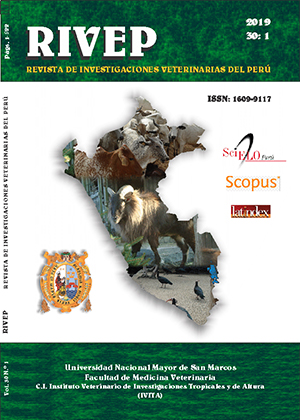Determinación del estado ácido-base en mulas de trabajo
DOI:
https://doi.org/10.15381/rivep.v30i1.15671Palabras clave:
équidos de trabajo, diferencia de iones fuertes, Hendersson-Hasselbach, lactatoResumen
Se realizó un estudio descriptivo para determinar la presentación de alteraciones ácido-base en mulas de trabajo. Se analizaron muestras de sangre de 29 mulares de carga. Se utilizaron tanto la aproximación tradicional (Henderson-Hasselbach) como el modelo de simplificado de diferencia de iones fuertes (Stewart). Los parámetros evaluados fueron pH, pCO2, HCO3 -, exceso de base, diferencia de iones fuertes, concentración total de aniones buffer no volátiles y lactato sanguíneo. El 48.3% de los individuos presentó al menos un desorden ácido-base mediante la aproximación tradicional, mientras que el 20.7% lo hizo mediante la aproximación de Stewart. Las alteraciones más comúnmente presentadas fueron alcalosis metabólica (20.7%), alcalosis respiratoria (13.8%), alcalosis hiperlactatémica (10.3%) y acidosis de iones fuertes (17.2%). Los resultados entre las dos aproximaciones no presentaron coincidencia. En conclusión, las alteraciones ácido-base en las mulas de trabajo pueden deberse a factores como el exceso de trabajo, la humedad relativa y la temperatura ambiental del sitio donde se realizó el estudio, que conllevan a marcadas pérdidas electrolíticas, y a la ausencia de suplementación de sales minerales en la dieta de los animales.
Descargas
Descargas
Publicado
Número
Sección
Licencia
Derechos de autor 2019 Valeria Trujillo Martínez, Carlos Salazar Latorre, Claudia Valderrama Martínez

Esta obra está bajo una licencia internacional Creative Commons Atribución-NoComercial-CompartirIgual 4.0.
LOS AUTORES RETIENEN SUS DERECHOS:
a. Los autores retienen sus derechos de marca y patente, y tambien sobre cualquier proceso o procedimiento descrito en el artículo.
b. Los autores retienen el derecho de compartir, copiar, distribuir, ejecutar y comunicar públicamente el articulo publicado en la Revista de Investigaciones Veterinarias del Perú (RIVEP)(por ejemplo, colocarlo en un repositorio institucional o publicarlo en un libro), con un reconocimiento de su publicación inicial en la Revista de Investigaciones Veterinarias del Perú (RIVEP).
c. Los autores retienen el derecho a hacer una posterior publicación de su trabajo, de utilizar el artículo o cualquier parte de aquel (por ejemplo: una compilación de sus trabajos, notas para conferencias, tesis, o para un libro), siempre que indiquen la fuente de publicación (autores del trabajo, revista, volumen, numero y fecha).



